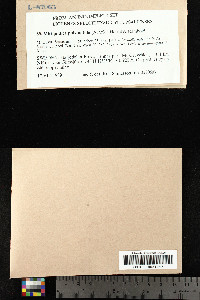
- Home
- Search
- Images
- Species Checklists
- US States: O-Z >
- US National Parks
- Central America
- South America
- US National Parks
- Southern Subpolar Region
|
|
|
|
Family: Lecanoraceae
[Lecidea circumnigrata H. Magn.] |
Thomson, J. W. (1997). American Arctic Lichens: The microlichens (Vol. 2). Univ of Wisconsin Press. Thallus gray to dark gray, tiny, to 1 cm, rimose-areolate, the small areolae to 0.5 mm, flat, in radiating lines on the orbicular thallus, especially on flat, smooth rocks, showing the black hypothallus between and marginally, with somewhat the aspect of Aspcilias in the Radiantes group. Apothecia small, to 0.5 mm broad, broadly adnate; margin slightly paler than black disk; exciple with blue-green exterior, hyphae somewhat cellular-radiate, interior pale; hypothecium hyaline; epihymenium greenish black; hymenium 45-55 µm, hyaline, I+ dark blue, as is hypothecium; paraphyses conglutinate, 2 µm, simple, tips larger, asci clavate; spores 8-13 X 4.5-5 µm. Reactions: K-, C-, KC-, P-, I- (except hypothecium and hymenium). This species grows on exposed rocks and is usually associated with Tremolecia atrata. It is known from Fennoscandia and the Alps in Europe, Spitzbergen, Ellesmere Island, and the Northwest Territories. Var. reagens Magnusson is based on a red reaction of the exciple with KOH. Species in WIS and CANL representing this variety were determined by H. Hertel from Coppermine, Artillery Lake, Bathurst Island, and Axel Heiberg Island. Var. circumnigrata occurred mixed with var. reagens at Mould Bay, Prince Patrick Island. Thompson, J., 1997. American Arctic Lichens: The Microlichens. Thallus gray to dark gray, tiny, to 1 cm, rimose-areolate, the small areolae to 0.5 mm, flat, in radiating lines on the orbicular thallus, especially on flat, smooth rocks, showing the black hypothallus between and marginally, with somewhat the aspect of Aspicilias in the Radiantes group. Apothecia small, to 0.5 mm broad, broadly adnate; margin slightly paler than black disk; exciple with blue-green exterior, hyphae somewhat cellular-radiate, interior pale; hypothecium hyaline; epihymenium greenish black; hymenium 45-55 μm, hyaline, 1+ dark blue, as is hypothecium; paraphyses conglutinate, 2 μm, simple, tips larger; asci clavate; spores 8-13 x 4.5-5 μm. Reactions: K—, C—, KC—, P—, I— (except hypothecium and hymenium). This species grows on exposed rocks and is usually associated with Tremolecia atraía. It is known from Fennoscandia and the Alps in Europe, Spitzbergen, Ellesmere Island, and the Northwest Territories. Var. reagens Magnusson is based on a red reaction of the exciple with KOH. Specimens in WIS and CANL representing this variety were determined by H. Hertel from Coppermine, Artillery Lake, Bathurst Island, and Axel Heiberg Island. Var. circumnigrata occurred mixed with var. reagens at Mould Bay, Prince Patrick Island. |
|
|
|





















